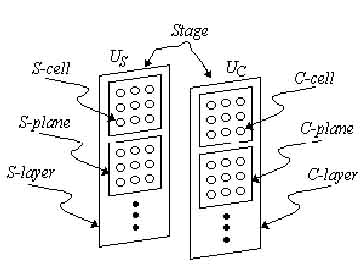
Department of Electronics and Computer Science, University of
Southampton, Highfield, Southampton, SO 17 1BJ UK
School of Computing, National University of Singapore,
Lower Kent Ridge Road, Singapore 119260
Department of Computing, The Hong Kong Polytechnic University,
Hung Horn, Kowloon, Hong Kong
The further study on the sensitivity analysis of Neocognitron is discussed in this paper. Fukushima's Neocognitron is capable of recognizing distorted patterns as well as tolerating positional shift. Supervised learning of the Neocognitron is fulfilled by training patterns layer by layer. However, many parameters, such as selectivity and receptive fields are set manually. Furthermore, in Fukushima's original Neocognitron, all the training patterns are designed empirically. In this paper, we use Genetic Algorithms (GAs) to tune the parameters of Neocognitron and search its reasonable training pattern sets. Four contributions are claimed: first, by analyzing the learning mechanism of Fukushima's original Neocognitron, the correlations amongst the training patterns are claimed to affect the performance of Neocognitron, tuning the Neocognitron's number of planes is equivalent to searching reasonable training patterns for its supervised learning; second, a GA-based supervised learning of the Neocognitron is carried out in this way, searching the parameters and training patterns by GAs but specifying the connection weights by training the Neocognitron; third, other than traditional GAs which are unsuitable for the large searching space of training patterns set, the cooperative coevolution is incorporated to play this role; fourth, an effective fitness function is given out when applying the above methodology into numeral recognition. The evolutionary computation in our initial experiments is implemented based on the original training pattern set, e.g. the individuals of the population are generated from Fukushima's original training patterns during initialization of GAs. The results prove that our correlation analysis is reasonable, and show that the performance of a Neocognitron is sensitive to its training patterns, selectivity and receptive fields, especially, the performance is not monotonically increasing with respect to the number of training patterns, and this GA-based supervised learning is able to improve Neocognitron's performance.
Fukushima's Neocognitron is well-known for its performance in visual pattern recognition. The Neocognitron divides the visual patterns into many sub-patterns (features) and distributes them into different feature planes which are linked in a hierarchical manner.
The Neocognitron consists of two types of neurons, i.e., S-cells which undertake feature extraction, and C-cells which take charge of the toleration of the deformation. There are two important parameters for each S-cell, one is its receptive field which specifies the number of its input interconnection, the other is its selectivity which is a threshold to control its response to features.
Many researchers, including Fukushima himself, have made efforts to improve the performance of the Neocognitron. In our previous work, it was proved that the Neocognitron is sensitive to three parameters, i.e., number of planes, receptive field and selectivity.8 This paper is aimed to tune these parameters to reach the goal.
In the conventional neocognitron, the amount of blurring produced by the C-cells is uniform in the receptive field of each S-cell. An S-cell would accept a much larger deformation if a nonuniform blurring could be produced in such a way that a larger blurring is generated in the periphery than at the center of the receptive field. This is desirable as discrepancies between a training pattern and a deformed stimulus pattern usually becomes larger in the periphery than at the center of the receptive field. In order to produce such a nonuniform blurring economically, Fukushima proposed an improved Neocognitron with a dual C-cell layer.
Considering the difficulty of interpreting and manipulating the interlayer connection denoted by connection weights, multi-layered attributed graphs were mapped to this hierarchical structure in our previous work,10 as well as a rule-based system was embedded in.11'12 The rule-based system helps the Neocognitron to initialize its weights instead of training. The parameters in the rule-based system are assigned by domain expert, which are then mapped into the Neocognitron as its connection weights.
Trotin et al. propose methods to build the Neocognitron dynamically, as well as to lower the threshold (i.e., the selectivity) automatically.13 The whole network architecture of the Neocognitron is built from setting zero planes in each layer at the beginning. The size adaptation of the network for a given application helps users reduce the effort in parameter adjustment. They also take advantage of a feedback signal to evaluate the effect of decreasing threshold, and then to tune thresholds based on the evaluation. The result of recognition after this threshold tuning is claimed to be as good as the result using manual adjustment of thresholds. However, the detail mechanism of the feedback signal has not been given out, and they confessed that the automatic adjustment of thresholds was difficult in their proceeding research.
Regarding the Neocognitron as a linear correlation classifier, Hildebrandt proposed his optimal closed-form training to the Neocognitron, the thresholds of cells were modified, so that the Neocognitron became an optimal classifier.15 Lovell got failed when applying Hildebrandt's optimal closed-form training,16 while, Hildebrandt explained that the training should not be applied to every layer of a network but the output layer only. As a matter of fact, Hildebrandt did not take care that the information lost layer by layer when propagating in the network.
Van Ooyen and Niehuis introduced a new parameter to improve the discriminating power of the Neocognitron.17 In fact, this parameter serves as an inhibitory signal, which suppresses the firing of neuron to the repeatedly stimulated features. Most neural networks memorize the training information in their weights. According to the Hebbian learning rule, the more times the feature is presented in the past, the easier the same feature are detected by the neural networks. However, such an opposite idea, which sets a difficult way for the repeatedly stimulated features, enables the network to identify these distinctive features which help discriminating different patterns.
Simulating biological evolution, Genetic Algorithms offer a class of global search techniques based on the learning process of a population of individuals. Each individual represents a potential solution to a given problem. Some researchers are being engaged in the approaches to construction of a neural networks based on Genetic Algorithms.18'19 The general method is to construct a linear chromosome and a 2-dimensional directed graph to represent the network, the chromosome designating the genetic operators are applied to which position, while, the directed graph indicating which genes will be involved in this operation correspondent with this position.
On the basis of the sensitivity analysis of the neocognitron model, we had presented a parameter tuning (namely selectivity) methodology for the Neocognitron in our previous work,20 as well as its application to handwritten numeral recognition. The performance improvement shows that it is more promising to tune parameters than set them manually. Nevertheless, a more efficient evolutionary algorithm is required to search reasonable parameters and topology which would be difficult by traditional Genetic Algorithms because of the large number of genes involved.
In traditional GAs, each individual is a potential complete solution to the problem, but in Cooperative Coevolutionary algorithms21"24 each individual represents only a partial solution to the problem. The goal of an individual is thus to optimize one piece of the solution and cooperate with other partial solutions that optimize other pieces so as to search for the entire solution effectively. Moreover, by maintaining the different solution pieces in a single population, the population does not converge to a single individual, e.g. diversity is maintained. Moriarty and Miikulainen set up a symbiotic adaptive neuroevolution (SANE) system to coevolve a population of neurons that cooperate to form a functioning network. In this process, neurons assume different but overlap roles, resulting in a robust encoding of control behavior. SANE is shown to be more efficient and more adaptive. It also maintain higher levels of diversity than the more common network-based population approaches.
Evolutionary computation for interconnection weights must concern real-valued GA. Maniezzo enhanced the exploration abilities by providing the search-space reducing evolution of both coding granularity and network topology.26 In his contribution, a connectivity is coded by presence/absence bits (the connectivity bits) relative to each possible arc of the complete graph and the first byte of the string specifies the number of bits (the granularity) according to which the weights of the present connections have been codified. However, the Neocognitron is a complicated network which involves thousands of weights, so that, it is unfeasible to search for the weights by GAs.
This paper will incorporate cooperative coevolu-tionary algorithms into supervised learning of the Neocognitron to search for better parameter values and training patterns. Also regarding the Neocognitron as a correlation classifier, we will evaluate the training patterns by correlation analysis. It is organized as follows: in Sec. 2, two important parameters of the Neocognitron, i.e., receptive field and selectivity, are discussed in detail. In Sec. 3, after analyzing the learning mechanism of the Neocognitron, we draw a conclusion that tuning the number of S-cell-planes of the Neocognitron is actually searching for the training patterns for supervised learning. In Sec. 4, we point out that the original Neogoni-tron lacks correlation analysis when designing the training patterns. Then we describe a methodology to incorporate the cooperative coevolution algorithm to find the better Neocognitron in Sec. 5. Finally, the methodology is applied to handwritten numeral recognition in Sec. 6, and the experimental results showed our GA-based supervised learning of Neocognitron is able to improve the performance of Neocognitron.
In this section, we will introduce the two parameters of Neocognitron, i.e., receptive field and selectivity. However, number of planes, which are closely relevant to the training patterns, will be discussed in the next section.
The Neocognitron tries to model the visual system which can recognize an object even the object shifts its position and is slightly deformed. The Neocognitron can learn from the stimulus patterns with shift invariance ability and can be generalized to recognize any unseen deformed version of these patterns. The Neocognitron consists of simple cells, called S-cells, and complex cells, called C-cells. In Fig. 1,

Fig. 1. Hierarchical relationship among cell, plane, layer and stage in the Neocognitron.
S-cells are grouped together to form S-planes which are combined to form an S-layer, denoted as Us. The similar relationship exists among C-cells, C-planes, C-layer[Uc). S-layer and C-layer are put together to form an intermediate stage of the network. In the input stage, the only layer involved is a 2-dimensional plane UQ which accepts 2-dimensional visual patterns directly. It simplifies the knowledge representation for input. In fact, the feature extraction step has been embedded in the connection scheme of the Neocognitron model. For character recognition, the output stage consists of S-layer and C-layer where every C-plane has only one C-cell which represents a category of characters.
In the Neocognitron, only the input interconnections to S-cells are variable and modifiable and the input interconnections to other cells are fixed and unmodi-fiable. Fukushima use the notation usi (ki, n) to represent the output of an S-cell in the /c;th S-plane in the Zth stage, and uci (ki, n) to represent the output of a C-cell in the /c;th C-plane in that stage, where n is the 2-dimensional coordinates representing the position of these cell's receptive fields on the input layer.
From the biological perspective, the visual stimulus light passes through the eyes and hits the retina. The retina ganglion cell collect the signals from a group of photoreceptors which form the receptive field of the cell. The concept of the receptive field of a cell in the Neocognitron comes from this biological phenomenon. The retina ganglion cell sends signals to lateral geniculate body (LGB) so that the signals are arranged correctly for transmission in the visual cortex. This process is simulated by an input layer in the Neocognitron illustrated in Fig. 2.
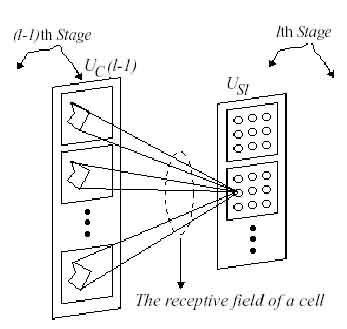
The size of the receptive field is set to be small in the first stage and to increase with the depth I.
In the Neocognitron, S-cells have inhibitory inputs with a shunting mechanism. The output of an S-cell of the /c;th S-plane in the Zth stage is given by:

where f[x] = max(x, 0). al(kl-1, t, kl;) and bl(kl) represent the values of the excitatory and inhibitory variable interconnecting coefficients, respectively. Figure 3 illustrate the input, output, interconnection and activation function of a S-cell.
Parameter r in Eq. (1), called selectivity, controls the intensity of the inhibition. The larger the value r is, the more selective becomes the cell's response to its specific feature.
The inhibitory cell V-cell, Vc(l-1)(n)> which is sending an inhibitory signal to cell Usl(kl, n), receives its input interconnections from the same cells as Usl (kl, n) does, and yields an output proportional to the weighted root-mean-square of its inputs:

The values of fixed interconnections Cl-1(t) are determined so as to decrease monotonically with respect to |t| and to satisfy 
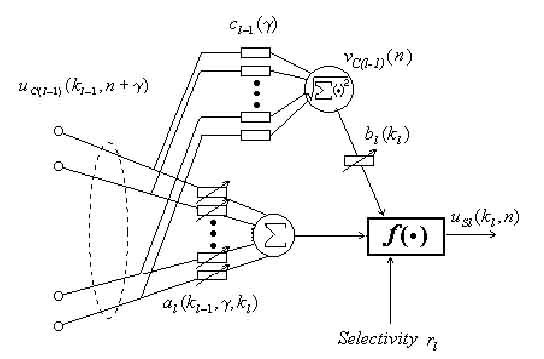
Fig. 3. The input, output, interconnection and activation function of a S-cell.
In this section, we will analyze the mechanism of supervised learning of Neocognitron, and then we can see that the topology of Neocognitron is actually specified by the training patterns.
In the early version of the Neocognitron, unsuper-vised learning (learning-without-a-teacher) predominate. Unsupervised learning which is utterly on the basis of self-organization is performed with two principles: 1. Reinforcement of Maximum- Output Cells. This is a winner-take-all strategy, only the one which is responding the strongest has its input connections reinforced. 2. Development of Iterative Connections.
The maximum-output cell in each cell-plane, not only has itself reinforced, but also controls the reinforcement of neighboring cells. As a result, connections develop iteratively in a cell-plane, hence, all the S-cells in a cell-plane grow to extract the same feature but in different position.
In the case of the above unsupervised learning, it takes considerable time to automatically find out seed cell which is the maximum-output amongst all of the cells in a layer when training a pattern. On the other hand, handwritten numeral recognition performs the classification not only on the basis of similarity in shape but also on the basis of certain convention, in other words, some case of geometrically similar patterns should not be classified into same categories, and vice versa.
The characteristics of supervised learning can be listed as follows:
The first two points will be discussed in detail in the next section. Now, let's explain the last one. In the case of character recognition, input characters have to be classified not only on the basis of geometrical similarity but also on the basis of customs by which some particular kinds of large deformation are admitted.
Sometimes when such deformation is too large, a single S-cell-plane is not enough to extract deformed versions of a feature. In such a case, another S-cell-plane is used to extract a deformed version of the feature, and the output from these S-cell-planes are made to converge to a single C-cell-plane.
We can see that, the topology of the Neocognitron is closely correspondent to the training patterns in supervised learning. Each S-cell-plane takes charge of extracting its own features, i.e., the training patterns set in advance by the supervisor. Fukushima's original Neocognitron, which consists of four stages, the cases are simple and clear for Us1 and Us4, but for Us2 and Us3, requires many patterns to tolerate the deformations and position shift. It is not only labor extensive but also incomplete to select training patterns manually. Figures 4(a) and 4(b) show the original training patterns for Us2 and Us3. Obviously, it is unconvincing that such patterns have included all the cases of the deformations and position shift.
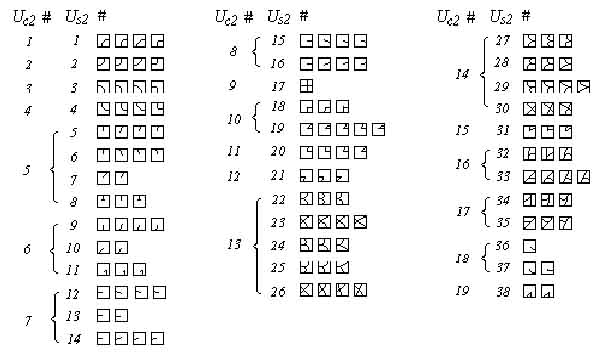
Fig. 4(a). Fukushima's training patterns for Us2.
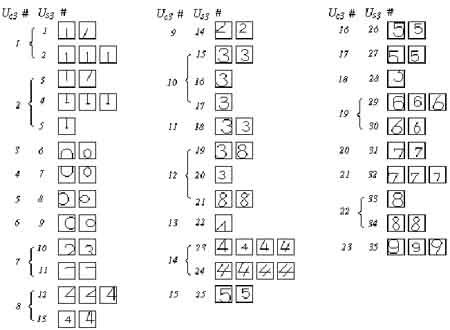
Fig. 4(a). Fukushima's training patterns for Us3.
The Neocognitron implements feature extraction by mapping a group of training patterns to a specified S-cell-plane. Training patterns in supervised learning are so important that they should be studied by theoretical and experimental analysis. Unfortunately, no research has been done on that.
Neocognitron is essentially a correlation classifier, in which an iterative procedure is used to compute the templates and thresholds corresponding to a given set of training patterns. A good Neocognitron should be satisfied with:
You can see that designing the training patterns is considerably difficult. Fukushima has given out a set of training patterns based on his many-year studies. Nevertheless, the training patterns must conform to the above criteria. To compute the correlations among training patterns, let's give a definition first.
Traverse feature. The number of traverse times when a scan line crosses the image.
As shown in Fig. 5, from the N*N dot-matrix F, we can obtain the TV-dimensional horizontal traverse feature vector TH and TV-dimensional vertical traverse feature vector TV'
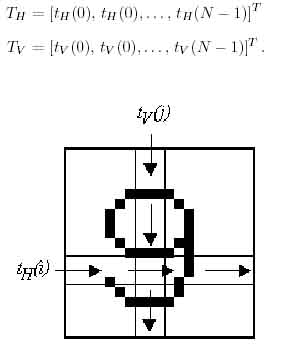
Fig. 5. Traverse feature.
Taking into consideration the translation and revolution of the image, a Rapid transformation should be implemented. Let the image size N be normalized to 2l, and T = {TH, Tv}, then the Rapid transformation of T can be divided into M = I + 1 steps, while the -Rth and (R — l)th steps meet the relationship as below:

where, i = 0, 1, 2,..., (M/2 - 1).
Now, {R(0), R(1),..., R(M - 1)} is the feature sequence after Rapid transformation. For each R(u) (u = 0, 1,..., M — 1), it is a linear combination of original functions T(i), and it can comprehensively express the features of a image. For example,  reflects the complexity of a numeral image. Therefore, Rapid transformed traverse features can describe a numeral image, and are insensitive to translation and slight revolution, hence, they are suitable for correlation analysis among the training patterns of Neocognitron.
reflects the complexity of a numeral image. Therefore, Rapid transformed traverse features can describe a numeral image, and are insensitive to translation and slight revolution, hence, they are suitable for correlation analysis among the training patterns of Neocognitron.
Correlation between two vectors X and Z can be defined to be the inner product of them divided by their magnitudes:  It is in fact the cosine of the angle between these two vectors. More S(X, Z) tending to the value 1, more similar the two vectors.
It is in fact the cosine of the angle between these two vectors. More S(X, Z) tending to the value 1, more similar the two vectors.
Correlation analysis amongst the training patterns is the factor why we should improve Fukushima's original Neocognitron, and it also can be used to evaluate the performance of a Neocognitron.
In traditional GAs, each individual in the population represents a complete solution that is independently of others in the population. Applying traditional GAs to the Neocognitron to search for a better topology is shown as Fig. 6.
There are two problems with this method: 1. GAs tend to focus the search toward a single dominant individual. 2. The length of a chromosome is too long to undertake an effecient evolution.
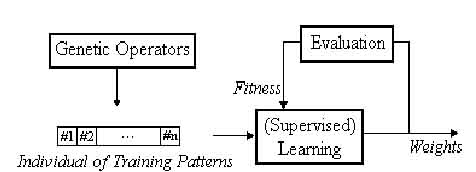
Fig. 6. Illustration of supervised learning for the neocognitron by traditional GAs.
This section describes how to incorporate cooperative coevolution into the supervised learning of the Neocognitron. When searching for the training patterns by cooperative coevolution, a training pattern is represented by its own chromosome which is a partial solution of the problem. And several such chromosomes cooperate to form a complete solution.
The work mode of supervised learning incorporated with cooperative coevolution can be illustrated as Fig. 7.

Fig. 7. Illustration of supervised learning for the Neocognitron incorporated with cooperative coevolution.
As aforementioned, tuning the number of S-cell planes of the Neocognitron is equal to searching for reasonable training patterns in supervised learning. Since no single training pattern can perform the whole task alone, the training pattern must optimize one aspect of the Neocognitron. In other words, a single training pattern will specify only one case of the deformation or positional shift of the visual image.
It can be divided into two level when cooperative coevolution is incorporated into training the Neocognitron, i.e., training pattern level and network level. At network level, each individual select some training patterns from the population of training patterns to form a potential network; at training pattern level, there is cooperation amongst the individuals to form a good network, as well as competition because of limited resource (limited number of S-planes and C-planes).
Moriarty and Miikkulainen's basic steps in one generation can be applied to our GA-based supervised learning of Neocognitron as follows:
There are two types of chromosome corresponding to the above two levels respectively. At training pattern level, any training pattern can be represented by a chromosome illustrated in Fig. 8, which consists of the coordinate of the receptive field of its seed-cells and its binary dot matrix.

Fig. 8. Chromosome at training pattern layer
At network level, each chromosome consists of receptive field, selectivity and training patterns for every layer, such like Fig. 9.

Fig. 9. Chromosome at network level.
Before we derive the fitness function of GAs, some variables are defined as follows: (i) c which presents the number of correctly recognized inputs, (ii) r which represents the number of rejected inputs. For a given input, if the winner of the output layer scores quite small, the input will be rejected, (iii) m which represents the number of misclassified inputs. Furthermore, the rules for designing a fitness function which represents a performance indicator p are:
i.e

or

Since the range of the terms on the right hand side of Eq. (2) is [0, 1], p could become unnecessarily small. For example, when half of the digits are correctly recognized and the other half are all rejected, the value of p is expected near 0.5, but it yields 0.25 only. When c >- r >- TO is taken into consideration, a possible proportional constant term could be  . Then Eq. (3) becomes:
. Then Eq. (3) becomes:

The performance indicator p will play the role of fitness function of GAs.
Our experiments implement the evolution on the basis of the Fukushima's original training patterns set, that is, during the procedure of initializing the population, any individual is randomly selected from the original training patterns with mutation in random positions.
The performance can be assessed by these two sets of testing samples, one is from Fukushima,6 the other is from Lovell.16 In fact, the first set is used to calculate the fitness during evolutionary computation, while, the second one is used to assess the whole performance. Because the training patterns for Usi and f/S4 are clear and simple, they are not concerned during evolution.
To analyze the relationship between the number of the plane and the performance of Neocognitron, let's observe the performance of the individuals at network level, in which the number of U$3 plane is from 30 to 50, as shown in Fig. 10.

Fig. 10. Number of planes versus the performance of Neocognitron.
We can see that the performance doesn't grow with the increasing the number of planes. Because in the supervised learning of Neocognitron, every training pattern will be presented to the input layer to train for the same times. If a training pattern is very similar to another one, it will make the Neocognitron more sensitive to this kind of feature.
So far, out of 6,000 different individuals at network level, five solutions have been found better than original one, and the best solution is given in Table 1 and Fig. 11.
Now, let's analyze the correlations amongst our new training patterns versus Fukushima's training patterns for Uss. Provided that we have got M training patterns, in which there are N\y ones belonging to a S-cell-plane W, the correlation amongst the N\y training patterns of W is called Si, whereas, the correlation between the patterns of W and the others belonging to different cell-planes is called So.
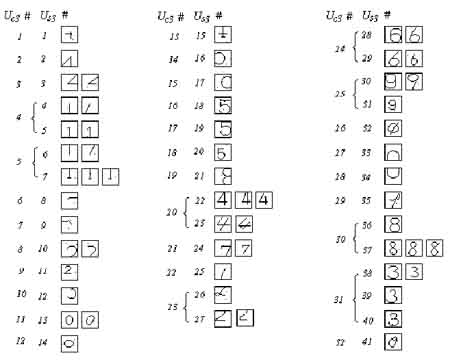
Fig. 11. Training patterns for US3 affiliated to Table 1.
Table 1. The best solution out of 6,000 different individuals at network level.
| Neocognitron | Receptive fields | Selectivity | Training patterns | Performance to Fukushima's test set | Performance to Lovell's test set |
| A1 A2 A3 A4 | t1 t2 t3 t4 | for Us2 for Us3 | p c r m | p c r m | |
| "Original" | 3*3 5*5 5*5 5*5 | 1.7 4.0 1.0 1.0 | Fig. 4(a) Fig. 4(b) | 0.43 0.53 0.13 0.34 | 0.43 0.50 0.26 0.24 |
| "GA-based" | 3*3 5*7 3*5 5*5 | 0.8 4.0 1.7 1.1 | Fig. 4(a) Fig. 11 | 0.50 0.59 0.15 0.26 | 0.56 0.63 0.18 0.19 |
Si and So can be computed as follows:

Si and So of Fukushima's original training patterns are shown in Fig. 12, and those of our new training patterns are shown in Fig. 13.
Generally speaking, the correlations in Fig. 13 amongst the patterns of the same categories are larger that those in Fig. 12, but the correlations amongst the patterns belonging to different S-cell-planes are smaller than those in Fig. 12. This is a reason why we can get a better Neocognitron than the original one. From Table 1, we can also see that the performance of Neocognitron is sensitive to the receptive fields and selectivity.
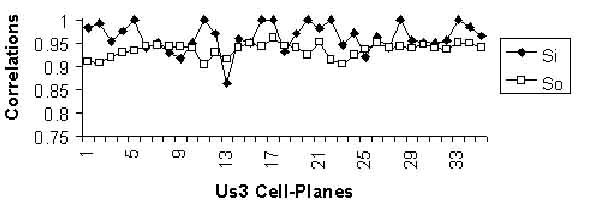
Fig. 12. Correlations amongst Fukushima's training patterns.
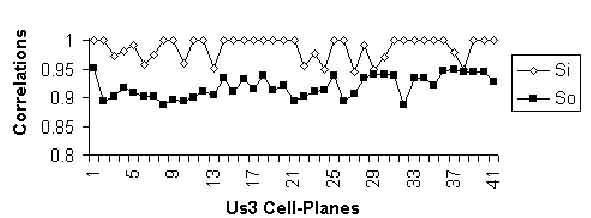
Fig. 13. Correlations amongst the training patterns in Fig. 11.
The Neocognitron is proved to be sensitive to three parameters, i.e., receptive fields, selectivity and number of planes. This paper discussed how to tune these parameters to improve the performance of the Neocognitron.
First of all, by analyzing the mechanism of Neocognitron's supervised learning in detail, this paper draws a conclusion that tuning the number of planes of Neocognitron is absolutely equivalent to searching appropriate training patterns for supervised learning. And the correlation analysis can be used to evaluate the training patterns. On the basis of original training patterns, the methodology and application is given out to incorporate cooperative coevolution into the Neocognitron to search training patterns and tune parameters. Our experimental results prove that correlation amongst the training patterns is a critical factor to affect the performance of Neocognitron, which has been concluded could be improved by the proposed GA-based supervised learning.
Regarding the low recognition rate, we will search training patterns for Us2 in our future work, as well as add one more stage into the Neocognitron. The other problem is, GAs' running tends to be more and more difficult to find out better solution. Our future work will study how to maintain the diversity of the population at network level. The correlation amongst the training pattern will be applied to preselection with respect to the population at training pattern level.